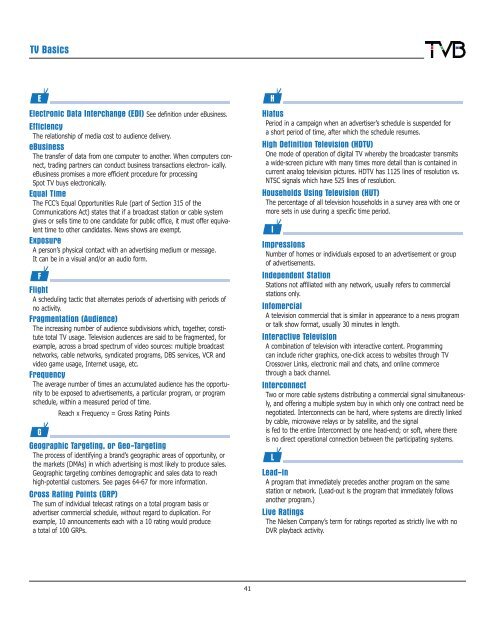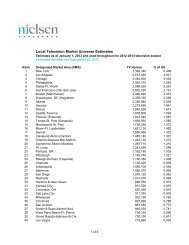TV Basics Online - Television Bureau of Advertising
TV Basics Online - Television Bureau of Advertising
TV Basics Online - Television Bureau of Advertising
Create successful ePaper yourself
Turn your PDF publications into a flip-book with our unique Google optimized e-Paper software.
<strong>TV</strong> <strong>Basics</strong><br />
E<br />
Electronic Data Interchange (EDI) See definition under eBusiness.<br />
Efficiency<br />
The relationship <strong>of</strong> media cost to audience delivery.<br />
eBusiness<br />
The transfer <strong>of</strong> data from one computer to another. When computers connect,<br />
trading partners can conduct business transactions electron- ically.<br />
eBusiness promises a more efficient procedure for processing<br />
Spot <strong>TV</strong> buys electronically.<br />
Equal Time<br />
The FCC’s Equal Opportunities Rule (part <strong>of</strong> Section 315 <strong>of</strong> the<br />
Communications Act) states that if a broadcast station or cable system<br />
gives or sells time to one candidate for public <strong>of</strong>fice, it must <strong>of</strong>fer equivalent<br />
time to other candidates. News shows are exempt.<br />
Exposure<br />
A person’s physical contact with an advertising medium or message.<br />
It can be in a visual and/or an audio form.<br />
F<br />
Flight<br />
A scheduling tactic that alternates periods <strong>of</strong> advertising with periods <strong>of</strong><br />
no activity.<br />
Fragmentation (Audience)<br />
The increasing number <strong>of</strong> audience subdivisions which, together, constitute<br />
total <strong>TV</strong> usage. <strong>Television</strong> audiences are said to be fragmented, for<br />
example, across a broad spectrum <strong>of</strong> video sources: multiple broadcast<br />
networks, cable networks, syndicated programs, DBS services, VCR and<br />
video game usage, Internet usage, etc.<br />
Frequency<br />
The average number <strong>of</strong> times an accumulated audience has the opportunity<br />
to be exposed to advertisements, a particular program, or program<br />
schedule, within a measured period <strong>of</strong> time.<br />
Reach x Frequency = Gross Rating Points<br />
G<br />
Geographic Targeting, or Geo-Targeting<br />
The process <strong>of</strong> identifying a brand’s geographic areas <strong>of</strong> opportunity, or<br />
the markets (DMAs) in which advertising is most likely to produce sales.<br />
Geographic targeting combines demographic and sales data to reach<br />
high-potential customers. See pages 64-67 for more information.<br />
Gross Rating Points (GRP)<br />
The sum <strong>of</strong> individual telecast ratings on a total program basis or<br />
advertiser commercial schedule, without regard to duplication. For<br />
example, 10 announcements each with a 10 rating would produce<br />
a total <strong>of</strong> 100 GRPs.<br />
41<br />
H<br />
Hiatus<br />
Period in a campaign when an advertiser’s schedule is suspended for<br />
a short period <strong>of</strong> time, after which the schedule resumes.<br />
High Definition <strong>Television</strong> (HD<strong>TV</strong>)<br />
One mode <strong>of</strong> operation <strong>of</strong> digital <strong>TV</strong> whereby the broadcaster transmits<br />
a wide-screen picture with many times more detail than is contained in<br />
current analog television pictures. HD<strong>TV</strong> has 1125 lines <strong>of</strong> resolution vs.<br />
NTSC signals which have 525 lines <strong>of</strong> resolution.<br />
Households Using <strong>Television</strong> (HUT)<br />
The percentage <strong>of</strong> all television households in a survey area with one or<br />
more sets in use during a specific time period.<br />
I<br />
Impressions<br />
Number <strong>of</strong> homes or individuals exposed to an advertisement or group<br />
<strong>of</strong> advertisements.<br />
Independent Station<br />
Stations not affiliated with any network, usually refers to commercial<br />
stations only.<br />
Infomercial<br />
A television commercial that is similar in appearance to a news program<br />
or talk show format, usually 30 minutes in length.<br />
Interactive <strong>Television</strong><br />
A combination <strong>of</strong> television with interactive content. Programming<br />
can include richer graphics, one-click access to websites through <strong>TV</strong><br />
Crossover Links, electronic mail and chats, and online commerce<br />
through a back channel.<br />
Interconnect<br />
Two or more cable systems distributing a commercial signal simultaneously,<br />
and <strong>of</strong>fering a multiple system buy in which only one contract need be<br />
negotiated. Interconnects can be hard, where systems are directly linked<br />
by cable, microwave relays or by satellite, and the signal<br />
is fed to the entire Interconnect by one head-end; or s<strong>of</strong>t, where there<br />
is no direct operational connection between the participating systems.<br />
L<br />
Lead-in<br />
A program that immediately precedes another program on the same<br />
station or network. (Lead-out is the program that immediately follows<br />
another program.)<br />
Live Ratings<br />
The Nielsen Company’s term for ratings reported as strictly live with no<br />
DVR playback activity.





